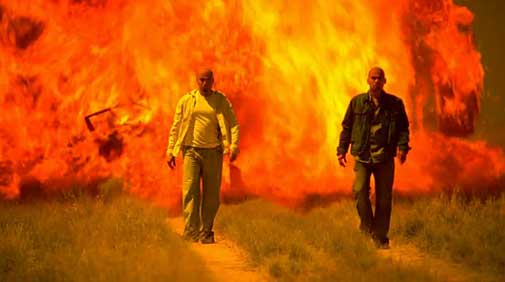
We've seen it all before: We're at a critical juncture in the story. The main character has just made a courageous or heartfelt speech, and, maybe after being met with Stunned Silence, makes for the exit.
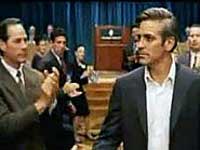
But just as the protagonist appears utterly defeated, one person in the crowd stands and starts to clap alone. Then a smattering of others. And, finally, the entire room of people erupts with crescendos of vindicating applause.
In the hands of gifted writers, directors and actors, it works, no matter how familiar it may seem. In lesser hands (so to speak), it's merely the sound of two hands clapping, slowly...
That commonly utilized, exponentially expanding applause is a drama standard, from classics like Hoosiers to cult favorites like Mystery, Alaska. It's called The Slow Clap, and even George Clooney walked to its rhythmically building accompaniment in Intolerable Cruelty. It's a virtual lock in almost any given teen movie these days, too.
For a clever montage of Slow Clap moments, including Clooney's, watch this YouTube offering:
And, although there's not really an Official Handbook -- although sometimes it feels like there is -- there IS a wiki website, TVtropes.org, which has an amazing and amusing catalog of just about every plot and genre standard imaginable.
You'll find everything from the Dark and Troubled Past (a character's complicated backstory, usually revealed in small bits) to the Sarcastic Confession (telling the truth sarcastically, so no one will take it seriously), and a lot more. They are sorted and organized by genre and type, and will keep you entertained for hours.
Begun in 2004 as a discussion board devoted to Buffy The Vampire Slayer, which had ended the year before, TVTropes evolved into a public wiki -- an encyclopedia -- of any kind of film and TV material. It soon outgrew even that, and expanded to include a variety of media. It now spans graphic novels, anime, music and even the plot lines of video and fantasy role-playing games.
It continues to grow. Anyone can post an idea for the wiki that, in time, could emerge as its own new page, forever listed alongside such proven standards as Hero Tracking Failure (in which, regardless of the setting and situation, the heavily armed bad guys cannot aim and shoot the unarmed hero, the bullets always striking mysteriously just behind him, never leading -- therefore being unable to hit him.)
Not that the standardization of drama, and action techniques, is new. The Greek tragedies had fairly strict narrative forms, and a standard set of dramatic tropes -- patricide, betrayal, seeing ghosts (see List of Transgressions) -- that were recycled even by Shakespeare, and continue to flourish in modern entertainments.
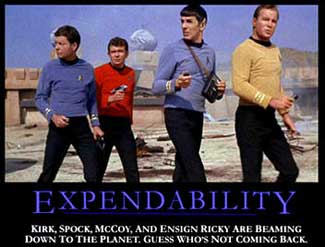
The most well-known modern example of a new trope filtering into our lexicon is The Red Shirt, a plot device from the original TV series Star Trek, when it quickly became clear that the fourth member of the landing party -- the unfamiliar ensign in a red-shirted security detail uniform, beamed down alongside Dr. McCoy, Mr. Spock and Captain Kirk -- was a sure goner, sometimes in the very first scene.
After a year or so of this, whenever we saw a new crewman, we knew he was toast. Says the wiki: "Their only job was to get eaten, shot, stabbed, disrupted, sped up and killed, frozen, desalinated, or turned into a cuboctahedron and crushed. Their death would give William Shatner and DeForest Kelley a corpse to emote over, and Leonard Nimoy a corpse to, well, not emote over."
A lot of the tropes at the site are hilarious and obviously long-honored, like The Air Vent Escape (with Bruce Willis shown below in an early Die Hard film).
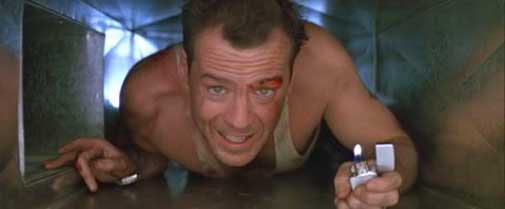
This is where heroes, no matter their weight or size, will find the right-sized passage in or out of a tight, otherwise trapped situation. Air vent covers "require little or no effort to remove, openings are always within reach, they're always able to support the weight of a person even though they were only designed to carry air."
And on it goes. There's The Unflinching Walk (in which the character sets an explosion and walks away, stone cold staring ahead, never turning to see the blast, as in the top photo with Tuco's stoic hit-men cousins from Season Three of Breaking Bad.)

And The Shower of Angst (characters so distraught, they numbly crouch in the shower, staring into space, as in the scene from Casino Royale at right.)
And Friends Rent Control (in which, as in the hit sitcom, hip, good looking New Yorkers have generous, affordable and stylish apartments explained away as being affordably cheap and under rent control.)
Perusing TV Tropes, I even found a personal peeve that's teed me off for years (go figure; see author's picture), where evil or deranged characters are almost always bald. It's listed in this wiki as its own trope, The Bald of Evil. (Hmm, come to think of it -- see, yet again, the cousins in the Breaking Bad photo.)
In no time, you'll be a Trope sophisticate, spotting, for example, the Conservation of Competence: "if the minions are smart, the boss must be an idiot. If the boss is smart, then his subordinates are stupid."
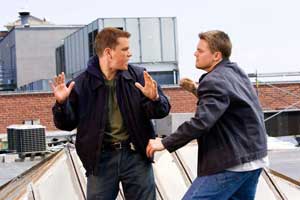 And surely, you'll easily be able to spot The Rooftop Confrontation (as seen at right, in the film The Departed), in which our hero usually winds up squaring off against the bad guy on a rooftop. Says the wiki: "It sometimes involves Roof Hopping if it takes place in the middle of a city, but sometimes a single rooftop can be just as badass, since it limits a character's maneuverability."
And surely, you'll easily be able to spot The Rooftop Confrontation (as seen at right, in the film The Departed), in which our hero usually winds up squaring off against the bad guy on a rooftop. Says the wiki: "It sometimes involves Roof Hopping if it takes place in the middle of a city, but sometimes a single rooftop can be just as badass, since it limits a character's maneuverability."
You've seen them all before. A lot. You'll just be able to mentally file them away a little easier now.
And, perhaps, hold Hollywood's writers to a higher standard...